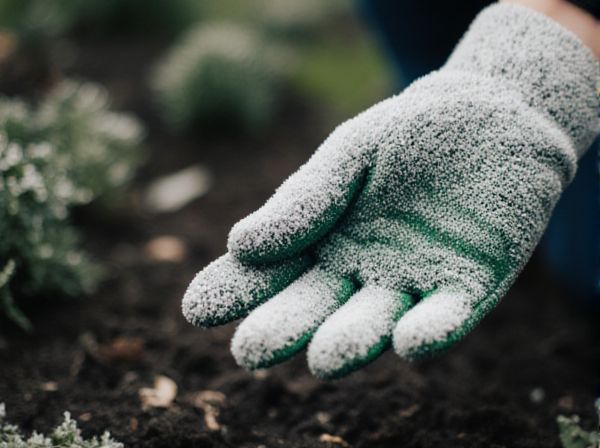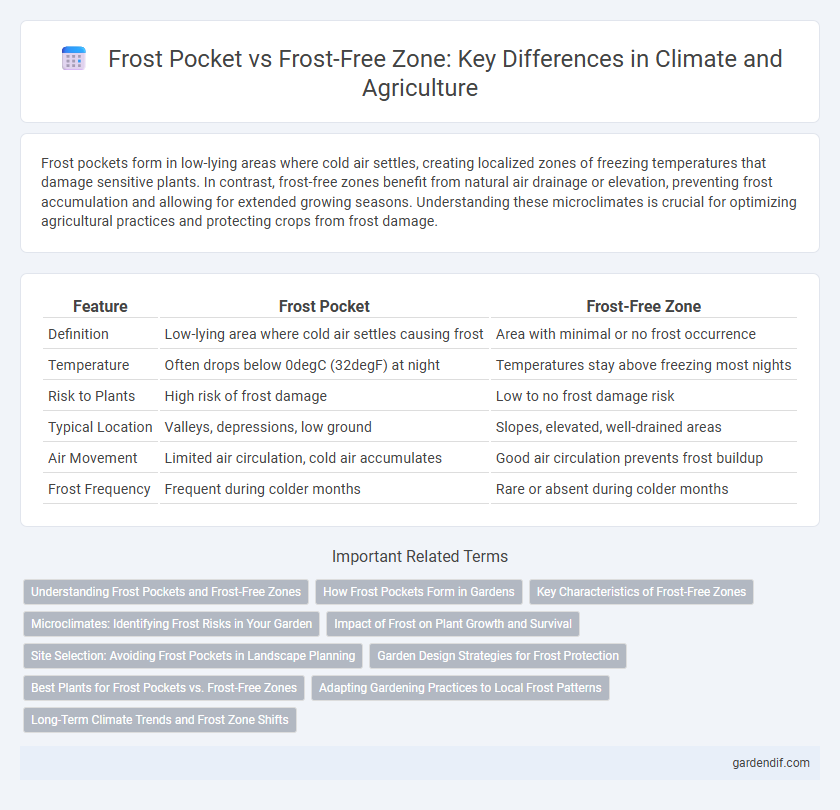
Frost pocket vs Frost-free zone Illustration
Frost pockets form in low-lying areas where cold air settles, creating localized zones of freezing temperatures that damage sensitive plants. In contrast, frost-free zones benefit from natural air drainage or elevation, preventing frost accumulation and allowing for extended growing seasons. Understanding these microclimates is crucial for optimizing agricultural practices and protecting crops from frost damage.
Table of Comparison
| Feature | Frost Pocket | Frost-Free Zone |
|---|---|---|
| Definition | Low-lying area where cold air settles causing frost | Area with minimal or no frost occurrence |
| Temperature | Often drops below 0degC (32degF) at night | Temperatures stay above freezing most nights |
| Risk to Plants | High risk of frost damage | Low to no frost damage risk |
| Typical Location | Valleys, depressions, low ground | Slopes, elevated, well-drained areas |
| Air Movement | Limited air circulation, cold air accumulates | Good air circulation prevents frost buildup |
| Frost Frequency | Frequent during colder months | Rare or absent during colder months |
Understanding Frost Pockets and Frost-Free Zones
Frost pockets are low-lying areas where cold air settles, leading to increased risk of frost formation and damage to sensitive plants. Frost-free zones are elevated or well-drained regions that experience minimal frost occurrence, providing safer conditions for agriculture and gardening. Identifying these areas is crucial for optimizing crop selection and protecting vulnerable vegetation from cold stress.
How Frost Pockets Form in Gardens
Frost pockets form in gardens when cold air sinks into low-lying areas, creating microclimates where frost is more likely to occur due to poor air drainage. These depressions trap denser, colder air overnight, leading to temperatures dropping below freezing even when surrounding higher areas remain frost-free. Understanding the formation of frost pockets is crucial for gardeners to protect sensitive plants by selecting frost-free zones or implementing frost mitigation strategies.
Key Characteristics of Frost-Free Zones
Frost-free zones are characterized by consistently higher nighttime temperatures that prevent the formation of ice crystals on surfaces, enhancing agricultural productivity and reducing crop damage. These zones typically occur in geographic areas with favorable microclimates, such as valleys with good air drainage or coastal regions where oceanic influences moderate temperature fluctuations. In contrast to frost pockets, frost-free zones exhibit minimal frost incidence, providing a more stable environment for frost-sensitive plants and extending growing seasons.
Microclimates: Identifying Frost Risks in Your Garden
Frost pockets are low-lying areas where cold air settles, creating microclimates with higher frost risk that can damage sensitive plants, while frost-free zones are elevated or well-drained regions less prone to freezing temperatures. Understanding these microclimates helps gardeners strategically select frost-tolerant species and optimize plant placement to minimize frost damage. Using tools like temperature sensors and topographic maps enhances the identification of frost pockets and improves microclimate assessment for effective garden management.
Impact of Frost on Plant Growth and Survival
Frost pockets are low-lying areas where cold air settles, increasing the risk of frost damage to plants by causing cell rupture and inhibiting growth. In contrast, frost-free zones maintain temperatures above freezing, allowing plants to thrive without frost-induced stress. Understanding the microclimate variations between these zones is crucial for selecting frost-resistant species and optimizing agricultural productivity.
Site Selection: Avoiding Frost Pockets in Landscape Planning
Frost pockets are low-lying areas where cold air settles, causing frequent and severe frost damage, making them unsuitable for frost-sensitive plants. Frost-free zones occur on elevated or well-drained sites with better air circulation, reducing frost risk and improving plant survival. Selecting planting sites with good air drainage and avoiding depressions ensures optimal microclimate conditions, minimizing frost hazards in landscape planning.
Garden Design Strategies for Frost Protection
Frost pockets are low-lying areas where cold air settles, increasing the risk of frost damage to plants; garden design strategies include elevating beds and selecting frost-resistant species to mitigate this. Frost-free zones benefit from natural air drainage, allowing for more diverse plant selection and less need for protective measures such as frost cloths or heaters. Incorporating windbreaks, thermal mass elements, and strategic plant placement can optimize microclimates to protect sensitive plants from frost in both environments.
Best Plants for Frost Pockets vs. Frost-Free Zones
Frost pockets are low-lying areas where cold air settles, causing temperatures to drop below freezing more frequently, making hardy plants like pansies, hellebores, and ferns ideal for these zones. Frost-free zones experience minimal to no frost, allowing more sensitive and tropical plants such as citrus trees, bougainvillea, and gardenias to thrive. Understanding the microclimate differences between frost pockets and frost-free zones is essential for selecting plants with the appropriate frost tolerance and growth requirements.
Adapting Gardening Practices to Local Frost Patterns
Adapting gardening practices to local frost patterns requires understanding differences between frost pockets and frost-free zones. Frost pockets are low-lying areas where cold air settles, increasing frost risk and necessitating frost-resistant plants or protective measures like mulching and frost cloths. In frost-free zones, gardeners can cultivate a wider variety of frost-sensitive crops year-round without extensive frost protection.
Long-Term Climate Trends and Frost Zone Shifts
Long-term climate trends reveal significant shifts in frost pockets and frost-free zones, driven by rising global temperatures and altered precipitation patterns. Frost pockets, typically low-lying areas prone to cold air accumulation, are shrinking as frost-free zones expand, impacting local agricultural practices and native ecosystems. Monitoring these shifts helps predict future frost risk, informing adaptive strategies for crop selection and land use planning under evolving climatic conditions.
Frost pocket vs Frost-free zone Infographic

 gardendif.com
gardendif.com